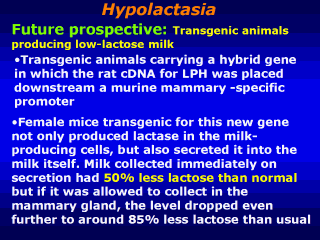
-
Hence, if applied to dairy
cattle, this could allow the easy and efficient production of low-lactose
milk to fulfill the requirements of lactose maldigesters, because a 50–70%
decrease in lactose is sufficient to prevent intestinal disorders after
milk ingestion.
|
First steps to low-lactose milk
ELEANOR LAWRENCE A cheap
and easily available low-lactose milk would be a welcome option for the 70%
of the adult population worldwide which has a problem with lactose
intolerance. Removing the lactose from milk can be done, but the process is
expensive and laborious. To this end, Bernard Jost and colleagues from the
Institut National de la Santé et de la Recherche Médicale in Strasbourg,
France have taken the first steps towards the production of transgenic
animals producing a nutritious but low-lactose milk. As they describe in
Nature Biotechnology
, the French researchers have produced mice that
express the lactose-digesting enzyme lactase in their mammary glands. This
lowers the amount of lactose in the milk by between 50 and 85% without any
obvious changes to its protein and fat content. The milk retained its
nutritional value as suckling mice reared on it grew and developed quite
normally. Human infants can digest large amounts of milk because they
produce the enzyme lactase in their digestive tract. But after weaning,
there is a quite normal decrease in the production of this enzyme. In a
considerable proportion of adults, the amounts of lactase produced are so
small that they cannot digest even the amount of lactose one would get from
a glass of milk. The undigested lactose in the small intestine causes
abdominal pain, nausea and diarrhea, which can lead to severe dehydration.
Lactase is normally produced only in the intestine and not in the mammary
gland. To get the mammary gland to produce lactase, Jost and colleages had
to construct an additional engineered lactase transgene that could be
introduced into mice and be expressed only in the mammary cells. They did
this by attaching the DNA sequence encoding the lactase protein to a
regulatory DNA sequence that directs its expression only in a lactating
mammary gland. Female mice transgenic for this new gene not only produced
lactase in the milk-producing cells, but also secreted it into the milk
itself, anchored in the outer membranes of the fat globules. Milk collected
immediately on secretion had 50% less lactose than normal but if it was
allowed to collect in the mammary gland, the level dropped even further to
around 85% less lactose than usual. |
